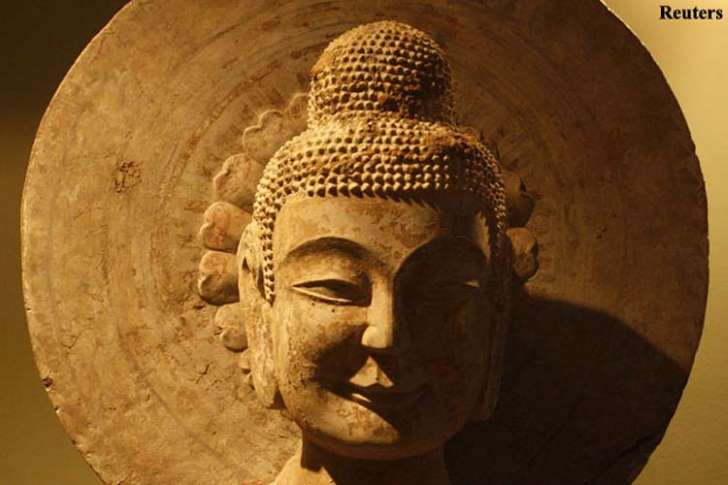August 15, 2012
In June 1916, an Indian living in California wrote a letter to The New York Times emphasizing how profoundly Indians in the United States had been influenced by the political values of their adoptive country.
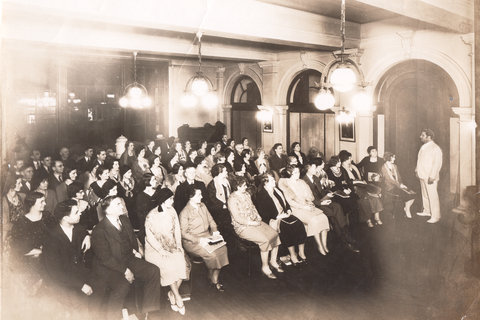
August 15, 2012
In June 1916, an Indian living in California wrote a letter to The New York Times emphasizing how profoundly Indians in the United States had been influenced by the political values of their adoptive country.

Bhagwan Singh Gyanee, extreme right, who was the president of the Gadar Party from 1914 to 1920, delivering a lecture in the United States in the 1930s.
“Residence in the U.S. has not made [Indians]…who returned home ‘imbued with revolutionary ideas’ but it has made them republicans.” He added, “The whole country has been stirred by their vision of a United States of India.”
The writer of the letter was Ram Chandra, the editor of Hindustan Gadar, the newspaper of the San Francisco-based Gadar Party. The party took its name from the Urdu word for “mutiny” or “revolt.” (The word is sometimes transliterated as “Ghadar.”) In its inaugural issue in November 1913, the newspaper had stated the party’s intentions clearly: “To bring about a rising…because the people can no longer bear the oppression and tyranny practiced under English rule.”
Most of the members of the Gadar Party were Punjabi, though their sympathizers were drawn from across India. Many of them had served in the British army or police services in places like Hong Kong and Shanghai and had moved to the United States to work as farm laborers or on building the railroads. A few were students at U.S. universities.
As India celebrates the 65th anniversary of its independence from Britain, the role of the Gadar Party and other Indians in the United States in helping the cause is garnering increased attention. Some of the new work is the result of African-American scholars examining the influence of the Indian struggle for freedom on the U.S. civil rights movement. Long before Martin Luther King began to study Gandhi’s works, African-American groups had established links with visiting Indian freedom fighters. Among them was Lala Lajpat Rai, who spent five years starting in 1915 as a political exile in the United States. He counted W.E.B. Du Bois among his friends, and also met with Booker T. Washington.
Other research into the subject represents the growing Indian-American community’s attempt to prove that its history in the United States is longer and more nuanced than is commonly known. These include a recent book by the historian Maia Ramnath, “Haj to Utopia: How the Ghadar Movement Charted Global Radicalism and Attempted to Overthrow the British Empire.”
Another initiative in this direction is the South Asian American Digital Archive, which was founded in Philadelphia in 2008 “to document and provide access to the diverse and relatively unknown stories of South Asian Americans.” Its collections chronicle a wide range of community experiences, and include several documents and photographs that throw light on the links between Indian-Americans and the Indian independence struggle.
“Historians will undoubtedly debate the legacy of the Gadar Party’s contributions to the overall freedom struggle for years to come,” said Samip Mallick, 31, the archive’s executive director, in an e-mail interview with India Ink. “But, symbolically, it is a really unique, extraordinary and inspiring story. The story of the Gadar Party is the story of a new immigrant population advocating for their own political enfranchisement, both through their support for decolonization around the world as well as through their fight for civil rights in their new home country.”
Here are excerpts from that interview:
Q.How did the Gadar Party influence India’s freedom struggle?
A.The Hindustan Gadar Party started off as a San Francisco-based anti-colonial political organization, which advocated the complete independence of India from British rule. The specifics of its founding are slightly murky, but it’s clear that in 1913, a group of activists based on the Pacific Coast, including Har Dayal and Sohan Singh Bhakna, were organizing migrant laborers (most of whom were Punjabi Sikhs) and helped found what would later be known as the Gadar Party, its aim being the overthrow of British colonial rule of India through revolutionary means. The Gadar Party published a newspaper titled Gadr in Urdu, followed by a Gurmukhi editions and apparently Gujarati editions. Copies of the newspaper as well as the party’s pamphlets were disseminated throughout the world, including Japan, China, Hong Kong, Burma and the Philippines, and eventually Gadar bases sprung up in those areas, as well. Gadar leaders also often wrote of the mistreatment of Indian immigrants in the U.S., which tells us that this was more than simply a nationalist organization.
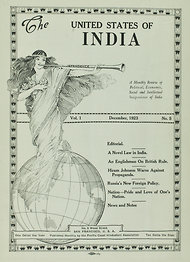
The Dec. 1923 issue of the “United States of India,” a Gadar Party publication.
The Gadar Party received considerable support from the German Foreign Office, which arranged funds and armaments in a plot to incite a pan-Indian revolution (later known as the “Annie Larsen affair”) in 1915. The conspiracy was discovered by British and American intelligence, and led to the Hindu-German Conspiracy Trial of 1917, in which 29 party members were convicted in the District Court in San Francisco.
The Gadar Party continued to exist after the trial, and in 1920 began to publish the Independent Hindustan, a journal containing editorials, essays and news items relating to the global movement for Indian independence. In 1923, the party began to publish The United States of India, for several years.
Q.Which other organizations in the U.S. supported Indian independence?
A. Alongside the Gadar Party was the India Home Rule League based in New York, founded by Lala Lajpat Rai, which advocated “home rule” for India. The I.H.R.L. produced a monthly journal from 1918 onward titled Young India. When Lajpat Rai left the U.S. in 1919, the editorship duties were handed off to Jabez T. Sunderland, a Unitarian minister who was a close associate of Rai and a longtime advocate for Indian independence. Another critical organization was Friends of Freedom for India, which was closely associated with the Gadar Party and led by Agnes Smedley and Sailendranath Ghose. Their mission, according to its own membership ads, was “to maintain the right of asylum for political refugees from India” and “to present the case for the independence of India.”
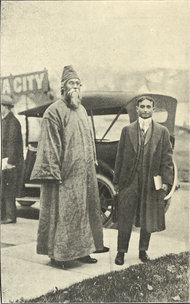
Rabindranath Tagore, left, and Sudhindra Bose at the University of Iowa in United States.
Incidentally, all three groups – the Gadar Party, the I.H.R.L., and the F.F.I. – enjoyed support from Irish nationalists, and published articles from Irish/Irish-American supporters. Other supporters of Indian freedom who traveled and lectured in the U.S. include Rabindranath Tagore, Kamaladevi Chattopadhyay, Ram Manohar Lohia and Vijaya Lakshmi Pandit.
Q. What was the U.S. government’s position on the Indian freedom struggle?
A. This is a pretty complex question, but it seems that before WWI, the U.S. government took a formal position of neutrality whenever possible, even while maintaining surveillance on the activities of Indians in the U.S. who advocated for independence. A few key American political figures like William Jennings Bryan, a member of the Anti-Imperialist league, wrote against British rule in India (Bryan’s 1906 essay “British Rule in India” was actually reprinted and circulated by the Gadar Party), but this wasn’t official state policy by any means. During WWI, the U.S. worked with British authorities to crack down the activity of Indian revolutionaries in the U.S., on the grounds that the Gadar radicals’ relationship with the German government was a violation of the neutrality laws. This resulted in the Hindu-German Conspiracy case of 1917.
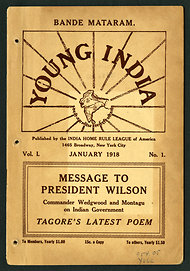
The first issue of “Young India” published in Jan. 1918 by the India Home Rule League based in New York.
Advocates for India’s freedom made much of President Woodrow Wilson’s “Fourteen Points” speech during WWI, which called for “a free, open-minded, and impartial adjustment of all colonial claims,” seeing this as a step forward towards decolonization and publishing praise for the president in Young India and various Gadar pamphlets. But even while most knew Wilson didn’t have India at the forefront of his mind when making such a claim, as historian Erez Manela puts it in “The Wilsonian Moment,” Wilson’s claim became part of their “rhetorical arsenal” for independence.
Q. What explains the recent spurt of books about the links between Indians in the U.S. and the freedom movement?
A. Part of the reason is that connections are being drawn between Asian-American Studies and what has traditionally been known as “area studies.” Also, transnational or diaspora studies, once seen as a footnote, has given us new focal points for examining the history of the freedom movement in India. The frame for analysis isn’t so nationally bound anymore.
However, while it is true that there are a number of new academic works on the Gadar Party and transnational involvement in the freedom struggle, there has been ongoing interest for many years in keeping these histories alive, beginning with even those who were themselves involved in the freedom struggle and worried that the tremendous sacrifices they made fighting for India’s independence would be forgotten and lost to history.
In 1953, writing from Mexico City, former Gadar Party member Pandurang Khankoje wrote to Bhagwan Singh Gyanee, asking the past leader for information to keep the story of Gadar alive. “People in India are anxious to know about you all,” Khankhoje said. “We are getting old and the history of our movement should not get lost.”
In the U.S. there have been a number of individuals, including T.S. Sibia, Jane Singh, Ved Prakash Vatuk, Irene Joshi, and others who have independently researched and worked to raise awareness about these important histories. There have also been organizations formed such as the Hindustan Gadar Party Memorial Committee to draw public attention to and publicly commemorate these histories. One of their major efforts was for the dedication of the building at 5 Wood Street in San Francisco as Gadar Memorial Hall, which is now owned and operated by the Indian Consular Office.
What is unique now, from the perspective of our work, is the opportunity provided by the digital medium to unify and provide universal access to dispersed archival materials in a way that was completely unimaginable even five or 10 years ago.
Q. How did the South Asian American Digital Archive go about collecting its materials?
A. Materials in the archive come to us generally in two ways. First are the materials that are held by individuals in their private collections. These are materials that have been collected over the years related to an individual’s family history or their own lives. Materials such as these would often stay in the basement or attic where they are kept and the important stories contained within these materials would not be widely shared. We work closely with such individuals to provide digital access to photographs, letters, journals and other such objects through our website while the original copies remain with their current owner.
Second are materials in institutions or archival repositories around the country. Few materials related to South Asian Americans are included in existing archives. For the vast majority of repositories, materials related to our community fall outside the scope of their collecting efforts. The materials that are available in archives are spread widely in collections across the country, making it difficult even for individual researchers to find the materials they need for their work and especially difficult for members of the community to access them. We have collaborated with a number of institutions to provide digital access to materials in their collections that are relevant to South Asian American history, but that may have otherwise been overlooked.
An example of such a collaboration is with the University of Pennsylvania Rare Book and Manuscript Library, which has a series of correspondence between Har Dayal, one of the leaders of the Gadar Party, and his close friend Van Wyck Brooks as part of their collection of Brooks’s papers. Collaboration with the University of Pennsylvania allowed us to provide digital access to these letters and allow users anywhere in the world to read Har Dayal’s words in his own hand for the very first time.
Courtesy: NY Times (By: Naresh Fernandes) — Photo Credits: Courtesy of South Asian American Digital Archives















































































































